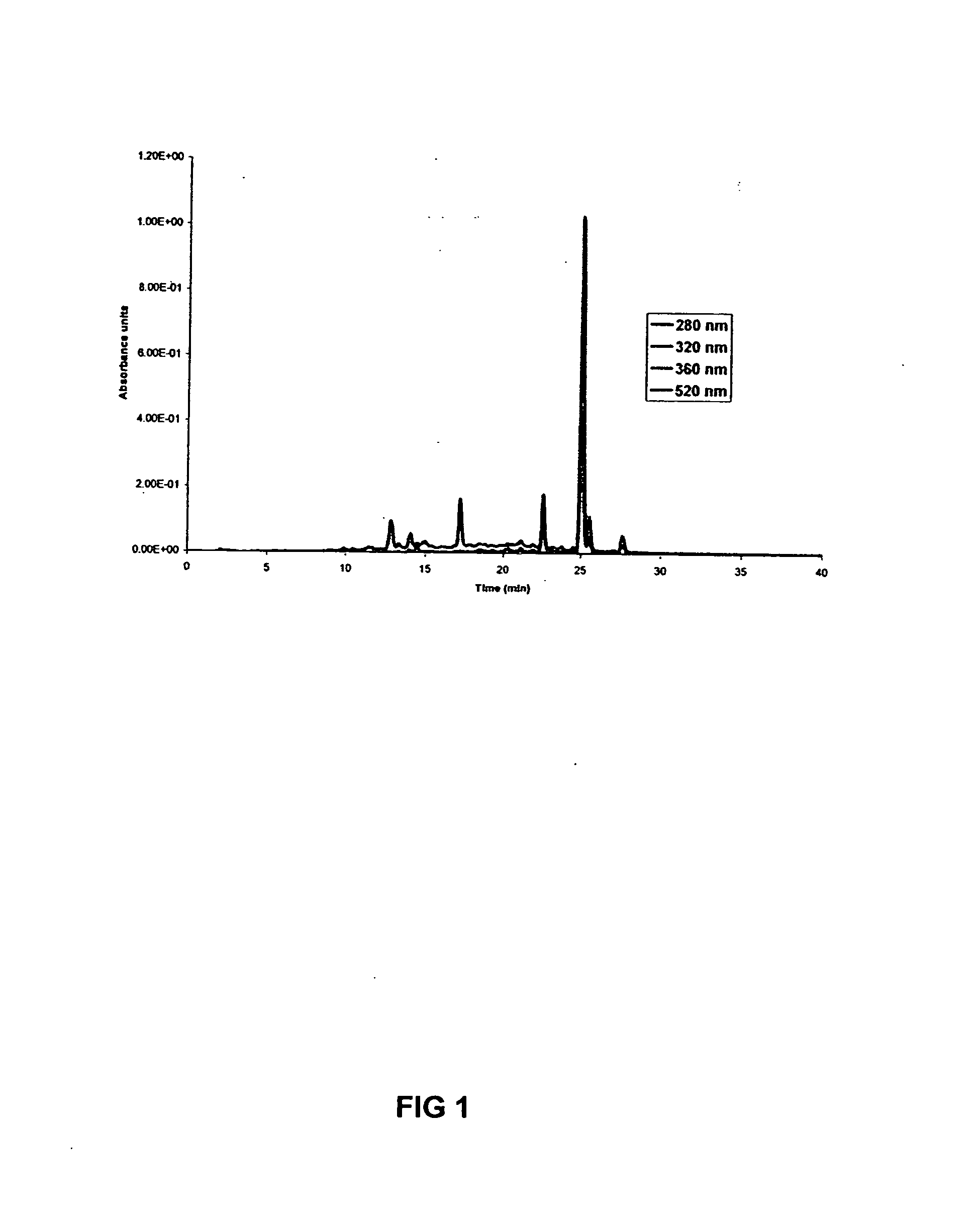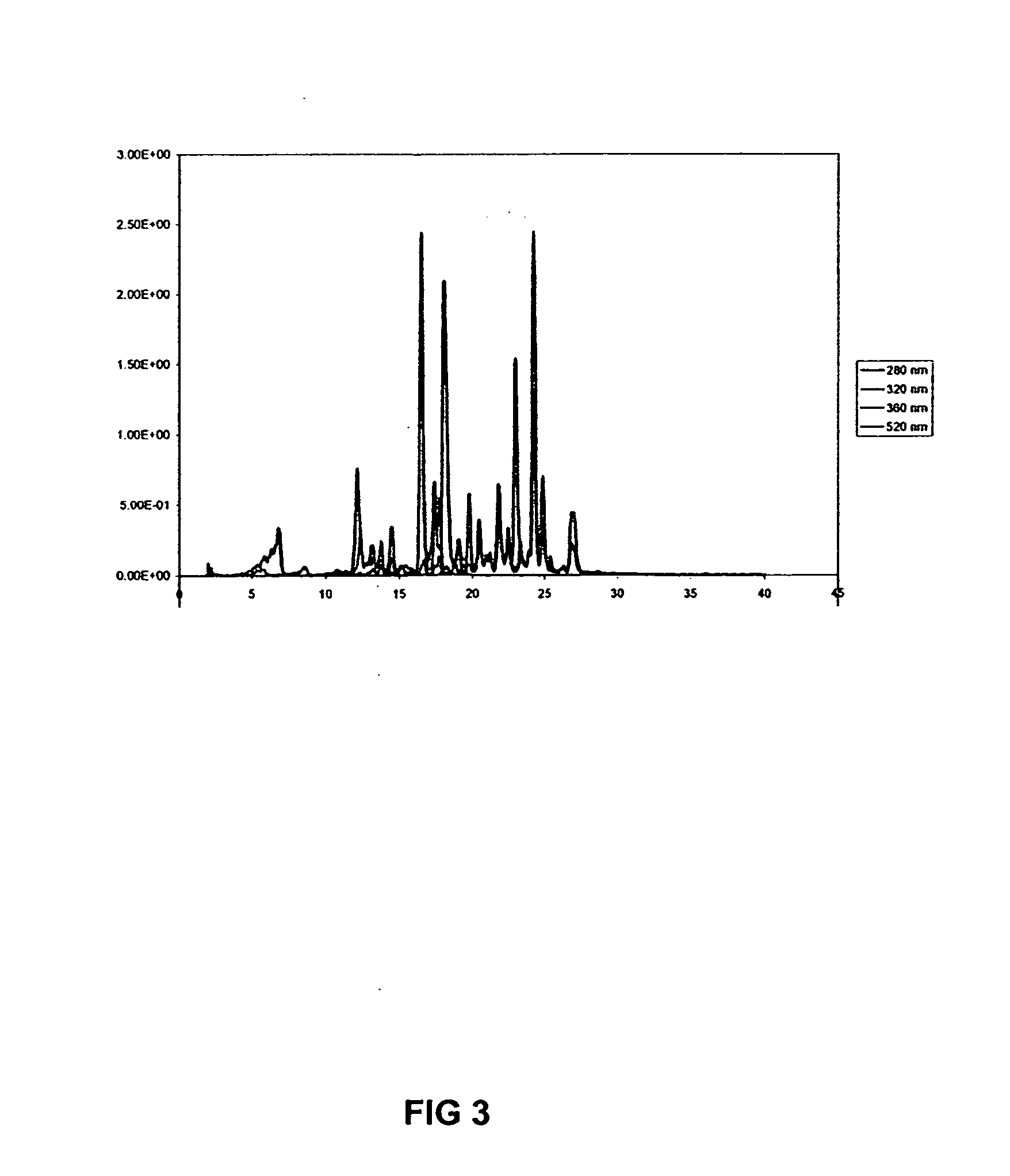Methods and compositions to inhibit lipid oxidation
- Summary
- Abstract
- Description
- Claims
- Application Information
AI Technical Summary
Benefits of technology
Problems solved by technology
Method used
Image
Examples
example 1
Identification of Cranberry Components that Best Inhibit Lipid Oxidation in Mechanically Separated Turkey (MST)
[0069] In practicing the present invention LH-20 resin and sequential water / ethanol / methanol / acetone solvents were utilized to prepare six fractions from cranberry. Further sub-fractionation of each fraction by analytical HPLC using C18 resin was performed to allow individual compounds to be resolved (water:methanol gradient). The predominant class of cranberry phenolics in each fraction was determined based on absorbance values at 280, 320, 360, and 520 nm. For example, fraction 2 was found to be rich in anthocyanins since the peaks had maximal absorbance at 520 nm. The chromatograph of fraction 4 indicated the presence of 4 flavonoids (360 nm absorbance) and 3 proanthocyanidins (280 nm) as shown in FIG. 1. Fraction 4 were found to be the most effective at inhibiting lipid oxidation in MST compared to the other fractions 1, 2, 3, 5, and 6; cranberry powder and crude extra...
example 2
Partitioning Measurements of Cranberry Antioxidants in Muscle Foods
[0094] A indicated hereinabove, it has been shown that lipophilic antioxidants (tocopherols) could be driven into the phospholipid membrane fraction of muscle foods and therefore oriented away from neutral lipids. This is desirable since phospholipids are believed to be the most susceptible lipid fraction to lipid oxidation processes (See, Gandemer et al., (1995) 119-128). Conveniently, the most powerful antioxidants in cranberry are highly lipophilic. This is based on applicants' observation that a chloroform extract from cranberry contains lipophilic compounds and was highly effective at inhibiting lipid oxidation in MST (FIG. 2). This strongly suggests that cranberry antioxidants can be driven into the membrane fraction where they are most needed. To confirm this, the partitioning of cranberry components in the different phases of muscle food systems may be measured (e.g., membrane phospholipids and neutral lipid...
example 3
Antioxidant Activities of Cranberry Components in Muscle Foods
[0102] In accordance with the invention, cranberry juice powder was extracted and fractionated with water, aqueous ethanol, methanol, and acetone. Cranberry press cake isolate was obtained by various solvent extractions (e.g., butanol, chloroform, dichloromethane, ethyl acetate, or ether). The level of thiobarbituric acid reactive substances (TBARS), indicators of lipid oxidation products, was determined by evaluating the inhibitory effects on the lipid oxidation in a mechanically separated turkey (MST) system. The antioxidant active cranberry components were partially characterized by reversed-phased High Performance Liquid Chromatography (HPLC) with UV-VIS diode array detection.
[0103] For example, in one study by the applicants, the effect of cranberry press cake on lipid oxidation in MST was analyzed. Press cake was initially extracted by acetone:H2O (7:3) and the resulting extract was referred to crude press cake. C...
PUM
 Login to View More
Login to View More Abstract
Description
Claims
Application Information
 Login to View More
Login to View More - R&D
- Intellectual Property
- Life Sciences
- Materials
- Tech Scout
- Unparalleled Data Quality
- Higher Quality Content
- 60% Fewer Hallucinations
Browse by: Latest US Patents, China's latest patents, Technical Efficacy Thesaurus, Application Domain, Technology Topic, Popular Technical Reports.
© 2025 PatSnap. All rights reserved.Legal|Privacy policy|Modern Slavery Act Transparency Statement|Sitemap|About US| Contact US: help@patsnap.com



